Chapter 7: Analog Modules
Apart from a large number of digital I/O lines, the PIC16F887 contains 14 analog inputs. They enable the microcontroller to recognize, not only whether a pin is driven to logic zero or one (0 or +5V), but to precisely measure its voltage and convert it into a numerical value, i.e. digital format. The whole procedure takes place in the A/D converter module which has the following features:- The converter generates a 10-bit binary result using the method of successive approximation and stores the conversion results into the ADC registers (ADRESL and ADRESH);
- There are 14 separate analog inputs;
- The A/D converter allows conversion of an analog input signal to a 10-bit binary representation of that signal; and
- By selecting voltage references Vref- and Vref+, the minimal resolution or quality of conversion may be adjusted to various needs.
ADC Mode and Registers
Even though the use of A/D converter seems to be very complicated, it is basically very simple, simpler than using timers and serial communication module, anyway.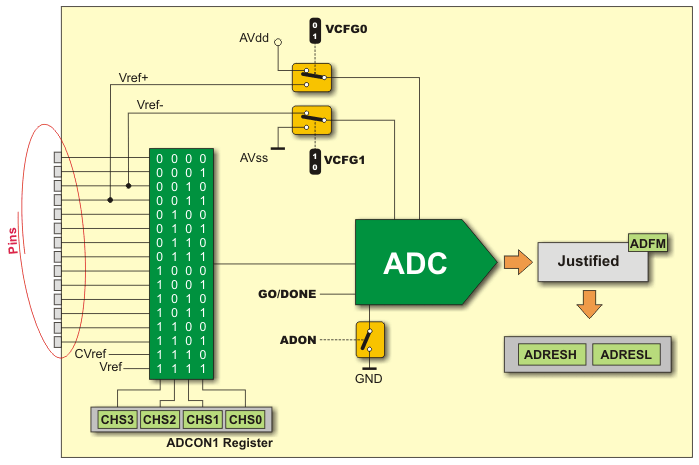
Fig. 7-1 ADC Mode and Registers
- ADRESH - Contains high byte of conversion result;
- ADRESL - Contains low byte of conversion result;
- ADCON0 - Control register 0; and
- ADCON1 Control register 1
ADRESH and ADRESL Registers
When converting an analog value into a digital one, the result of the 10-bit A/D conversion will be stored in these two registers. In order to deal with this value easier, it can appear in two formats- left justified and right justified. The ADFM bit of the ADCON1 register determines the format of conversion result (see figure 7-2). In the event that A/D converter is not used, these registers may be used as general-purpose registers.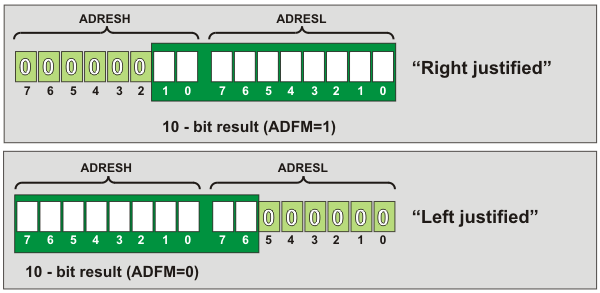
Fig. 7-2 ADRESH and ADRESL Registers
A/D Acquisition Requirements
For the ADC to meet its specified accuracy, it is necessary to provide a certain time delay between selecting specific analog input and measurement itself. This time is called "acquisition time" and mainly depends on the source impedance. There is an equation used for accurately calculating this time, which in the worst case amounts to approximately 20uS. Briefly, after selecting (or changing) the analog input and before starting conversion it is necessary to provide at least 20uS time delay to enable the ACD maximal conversion accuracy.ADC Clock Period
Time needed to complete a one-bit conversion is defined as TAD. The required TAD must be at least 1,6 uS. One full 10-bit A/D conversion is a bit longer than expected and amounts to 11 TAD periods. However, since both the conversion clock frequency and source are determined by software, one of the available combination of bits ADCS1 and ADCS0 should be selected before voltage measurement on some analog input starts. These bits are stored in the ADCON0 register.| ADC Clock Source | ADCS1 | ADCS0 | Device Frequency (Fosc) | |||
|---|---|---|---|---|---|---|
| 20 Mhz | 8 Mhz | 4 Mhz | 1 Mhz | |||
| Fosc/2 | 0 | 0 | 100 nS | 250 nS | 500 nS | 2 uS |
| Fosc/8 | 0 | 1 | 400 nS | 1 uS | 2 uS | 8 uS |
| Fosc/32 | 1 | 0 | 1.6 uS | 4 uS | 8 uS | 32 uS |
| Frc | 1 | 1 | 2 - 6 uS | 2 - 6 uS | 2 - 6 uS | 2 - 6 uS |
Table 7-1 ADC Clock Period
Any change in the system clock frequency will affect the ADC clock frequency, which may adversely affect the ADC result. Device frequency characteristics are shown in the table above. The values in the shaded cells are outside of recommended range.How to Use A/D Converter?
In order to enable the A/D converter to run without problems as well as to avoid unexpected results, it is necessary to consider the following:- A/D converter does not differ between digital and analog voltages. In order to avoid errors in measurement or chip damage, the pins should be configured as analog inputs before conversion starts. The bits used for this purpose are stored in the TRIS and ANSELH registers;
- When the port with analog inputs marked as CH0-CH13 is read, the corresponding bits will be driven to logic zero (0); and
- Roughly speaking, voltage measurement in the converter is based on comparing input voltage with internal scale which has 1024 marks (210=1024). The lowest scale mark stands for the Vref- voltage, whilst the highest mark stands for the Vref+ voltage. Figure 7-3 below shows selectable referent voltages and their minimum and maximum values as well.
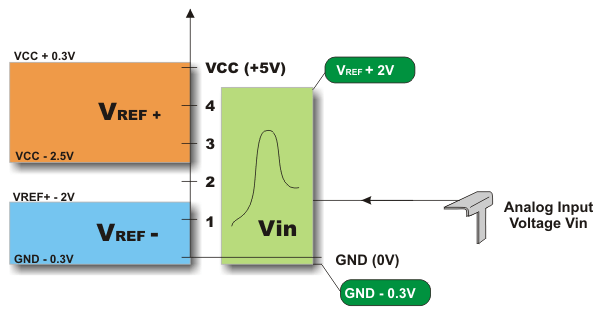
Fig. 7-3 How to Use The A/D Converter
ADCON0 Register

Fig. 7-4 ADCON0 Register
| ADCS1 | ADCS2 | Clock |
|---|---|---|
| 0 | 0 | Fosc/2 |
| 0 | 1 | Fosc/8 |
| 1 | 0 | Fosc/32 |
| 1 | 1 | RC * |
Table 7-2 A/D Conversion Select Bits
* Clock is generated by internal oscillator which is built in converter.CHS3-CHS0 - Analog Channel Select bits select a pin or an analog channel for conversion, i.e. voltage measurement:
| CHS3 | CHS2 | CHS1 | CHS0 | Channel | Pin | ||||||||||||||||||||||||||||||||||||||||||||||||||||||||||||||||||||||||||||||||||||||||||||||||||||||||||||||||||||||||||||||||||||||||||||||||||||||||||||||||||||||||||||||||||||||||||||||||||||||
|---|---|---|---|---|---|---|---|---|---|---|---|---|---|---|---|---|---|---|---|---|---|---|---|---|---|---|---|---|---|---|---|---|---|---|---|---|---|---|---|---|---|---|---|---|---|---|---|---|---|---|---|---|---|---|---|---|---|---|---|---|---|---|---|---|---|---|---|---|---|---|---|---|---|---|---|---|---|---|---|---|---|---|---|---|---|---|---|---|---|---|---|---|---|---|---|---|---|---|---|---|---|---|---|---|---|---|---|---|---|---|---|---|---|---|---|---|---|---|---|---|---|---|---|---|---|---|---|---|---|---|---|---|---|---|---|---|---|---|---|---|---|---|---|---|---|---|---|---|---|---|---|---|---|---|---|---|---|---|---|---|---|---|---|---|---|---|---|---|---|---|---|---|---|---|---|---|---|---|---|---|---|---|---|---|---|---|---|---|---|---|---|---|---|---|---|---|---|---|---|---|---|---|---|
| 0 | 0 | 0 | 0 | 0 | RA0/AN0 | ||||||||||||||||||||||||||||||||||||||||||||||||||||||||||||||||||||||||||||||||||||||||||||||||||||||||||||||||||||||||||||||||||||||||||||||||||||||||||||||||||||||||||||||||||||||||||||||||||||||
| 0 | 0 | 0 | 1 | 1 | RA1/AN1 | ||||||||||||||||||||||||||||||||||||||||||||||||||||||||||||||||||||||||||||||||||||||||||||||||||||||||||||||||||||||||||||||||||||||||||||||||||||||||||||||||||||||||||||||||||||||||||||||||||||||
| 0 | 0 | 1 | 0 | 2 | RA2/AN2 | ||||||||||||||||||||||||||||||||||||||||||||||||||||||||||||||||||||||||||||||||||||||||||||||||||||||||||||||||||||||||||||||||||||||||||||||||||||||||||||||||||||||||||||||||||||||||||||||||||||||
| 0 | 0 | 1 | 1 | 3 | RA3/AN3 | ||||||||||||||||||||||||||||||||||||||||||||||||||||||||||||||||||||||||||||||||||||||||||||||||||||||||||||||||||||||||||||||||||||||||||||||||||||||||||||||||||||||||||||||||||||||||||||||||||||||
| 0 | 1 | 0 | 0 | 4 | RA5/AN4 | ||||||||||||||||||||||||||||||||||||||||||||||||||||||||||||||||||||||||||||||||||||||||||||||||||||||||||||||||||||||||||||||||||||||||||||||||||||||||||||||||||||||||||||||||||||||||||||||||||||||
| 0 | 1 | 0 | 1 | 5 | RE0/AN5 | ||||||||||||||||||||||||||||||||||||||||||||||||||||||||||||||||||||||||||||||||||||||||||||||||||||||||||||||||||||||||||||||||||||||||||||||||||||||||||||||||||||||||||||||||||||||||||||||||||||||
| 0 | 1 | 1 | 0 | 6 | RE1/AN6 | ||||||||||||||||||||||||||||||||||||||||||||||||||||||||||||||||||||||||||||||||||||||||||||||||||||||||||||||||||||||||||||||||||||||||||||||||||||||||||||||||||||||||||||||||||||||||||||||||||||||
| 0 | 1 | 1 | 1 | 7 | RE2/AN7 | ||||||||||||||||||||||||||||||||||||||||||||||||||||||||||||||||||||||||||||||||||||||||||||||||||||||||||||||||||||||||||||||||||||||||||||||||||||||||||||||||||||||||||||||||||||||||||||||||||||||
| 1 | 0 | 0 | 0 | 8 | RB2/AN8 | ||||||||||||||||||||||||||||||||||||||||||||||||||||||||||||||||||||||||||||||||||||||||||||||||||||||||||||||||||||||||||||||||||||||||||||||||||||||||||||||||||||||||||||||||||||||||||||||||||||||
| 1 | 0 | 0 | 1 | 9 | RB3/AN9 | ||||||||||||||||||||||||||||||||||||||||||||||||||||||||||||||||||||||||||||||||||||||||||||||||||||||||||||||||||||||||||||||||||||||||||||||||||||||||||||||||||||||||||||||||||||||||||||||||||||||
| 1 | 0 | 1 | 0 | 10 | RB1/AN10 | ||||||||||||||||||||||||||||||||||||||||||||||||||||||||||||||||||||||||||||||||||||||||||||||||||||||||||||||||||||||||||||||||||||||||||||||||||||||||||||||||||||||||||||||||||||||||||||||||||||||
| 1 | 0 | 1 | 1 | 11 | RB4/AN11 | ||||||||||||||||||||||||||||||||||||||||||||||||||||||||||||||||||||||||||||||||||||||||||||||||||||||||||||||||||||||||||||||||||||||||||||||||||||||||||||||||||||||||||||||||||||||||||||||||||||||
| 1 | 1 | 0 | 0 | 12 | RB0/AN12 | ||||||||||||||||||||||||||||||||||||||||||||||||||||||||||||||||||||||||||||||||||||||||||||||||||||||||||||||||||||||||||||||||||||||||||||||||||||||||||||||||||||||||||||||||||||||||||||||||||||||
| 1 | 1 | 0 | 1 | 13 | RB5/AN13 | ||||||||||||||||||||||||||||||||||||||||||||||||||||||||||||||||||||||||||||||||||||||||||||||||||||||||||||||||||||||||||||||||||||||||||||||||||||||||||||||||||||||||||||||||||||||||||||||||||||||
| 1 | 1 | 1 | 0 | CVref | |||||||||||||||||||||||||||||||||||||||||||||||||||||||||||||||||||||||||||||||||||||||||||||||||||||||||||||||||||||||||||||||||||||||||||||||||||||||||||||||||||||||||||||||||||||||||||||||||||||||
| 1 | 1 | 1 | 1 | Vref = 0.6V | |||||||||||||||||||||||||||||||||||||||||||||||||||||||||||||||||||||||||||||||||||||||||||||||||||||||||||||||||||||||||||||||||||||||||||||||||||||||||||||||||||||||||||||||||||||||||||||||||||||||
Table 7-3 Analog Channel Status Bits
GO/DONE - A/D Conversion Status bit determines current status of conversion:- 1 - A/D conversion is in progress; and
- 0 - A/D conversion is complete. This bit is automatically cleared by hardware when the A/D conversion is completed.
- 1 - A/D converter is enabled; and
- 0 - A/D converter is disabled.
ADCON1 Register

Fig. 7-5 ADCON1 Register
- 1 - Conversion result right justified. Six most significant bits of the ADRESLH are not used; and
- 0 - Conversion result left justified. Six least significant bits of the ADRESL are not used.
- 1 - Negative voltage reference is applied on the Vref- pin; and
- 0 - Voltage power supply Vss is used as negative voltage reference source.
- 1 - Positive voltage reference is applied on the Vref+ pin; and
- 0 - Voltage power supply Vdd is used as positive voltage reference source.
In Short:
In order to measure voltage on an input pin by A/D converter the following should be done:Step 1 - Configuring port:
- Write logic one (1) to the corresponding bit of the TRIS register to configure it as input; and
- Write logic one (1) to the corresponding bit of the ANSEL register to configure it as analog input.
- Configure voltage reference in the ADCON1 register;
- Select ADC conversion clock in the ADCON0 register;
- Select one of input channels CH0-CH13 of the ADCON0 register;
- Select data format using the ADFM bit of the ADCON1 register; and
- Enable A/D converter by setting the ADON bit of the ADCON0 register.
- Clear the ADIF bit; and
- Set the ADIE, PEIE and GIE bits.
Step 5 - Start conversion by setting the GO/DONE bit of the ADCON0 register.
Step 6 - Wait for ADC conversion to complete.
- It is necessary to check in program loop whether the GO/DONE pin is cleared or wait for an A/D interrupt (must be previously enabled).
- Read the ADRESH and ADRESL registers.
Analog Comparator
In addition to A/D converter, there is one more module, which until quite recently has been embedded only in integrated circuits, belonging to so called analog electronics. Owing to the fact that it is hardly possible to find any more complex automatic device which in some way does not use these circuits, two high quality comparators along with additional electronics are integrated into the microcontroller and connected to its pins.How does a comparator operate? Basically, the analog comparator is an amplifier which compares the magnitude of voltages at two inputs. Looking at its physical features, it has two inputs and one output. Depending on which input has a higher voltage (analog value), a logic zero (0) or logic one (1) (digital values) will appear on its output:
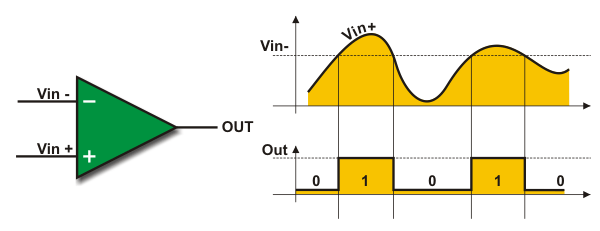
Fig. 7-6 Analog Comparator
- When the analog voltage at Vin- is higher than the analog voltage at Vin+, the output of the comparator is a digital low level; and
- When the analog voltage at Vin+ is higher than the analog voltage at Vin-, the output of the comparator is a digital high level.
These two circuits are under control of the bits stored in the following registers:
CM1CON0 is in control of comparator C1;
CM2CON0 is in control of comparator C2; and
CM2CON1 is in control of comparator C2.
Voltage Reference Internal Source
One of two analog voltages provided on the comparator inputs is usually stable and unchangeable. Because of those features it is called "voltage reference"(Vref). To generate it, both external and special internal voltage source can be used. After selecting voltage source, Vref is derived from it by means of ladder network consisting of 16 resistors which form voltage divider. The voltage source is selectable through both ends of that divider through the VRSS bit of the VRCON register.In addition, the voltage fraction provided by resistor ladder network may be selected through the bits VR0-VR3 and used as voltage reference. See figure below.
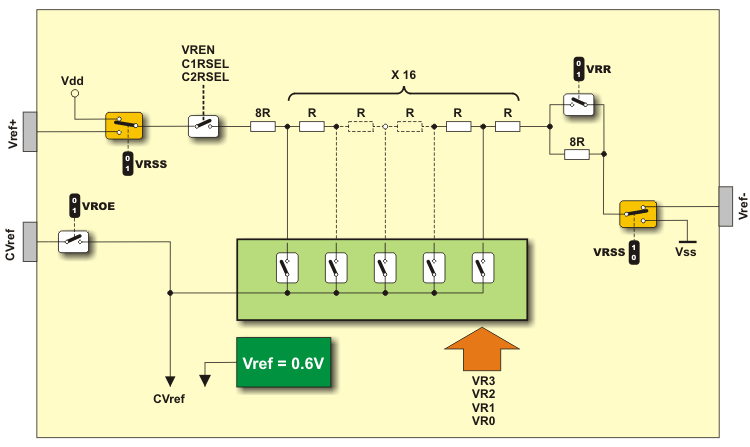
Fig. 7-7 VREF
Even though the main idea was to obtain varying voltage reference for the operation of analog modules, a simple A/D converter is obtained in that way too. This converter is very useful in some situations.
It's operation is under control of the VRCON register.
Comparators and Interrupt Operation
The flag bit CMIF of the register PIR is set on every change of logic state on any comparator's output. The same changes also cause an interrupt if the following bits are set:CMIE bit of the PIE register;
PEIE bit of the INTCON register; and
GIE bit of the INTCON register.
If interrupt is enabled, any change on the comparator's output can wake up the microcontroller from sleep mode if it is setup in that mode.
CM1CON0 Register

Fig. 7-8 CM1CON0 Regsiter
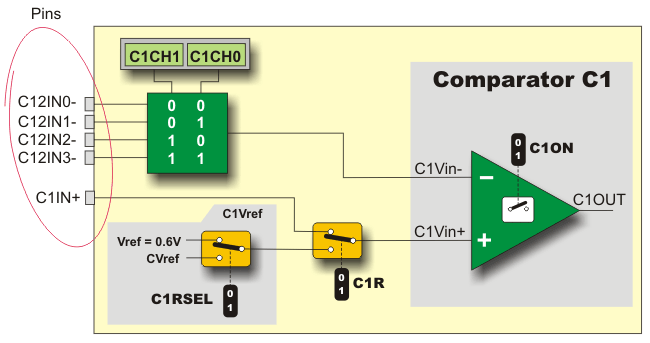
Fig. 7-9 Comparator C1 Enable Bit
- 1 - Comparator C1 is enabled; and
- 0 - Comparator C1 is disabled.
If C1POL = 1 (comparator output is inverted)
- 1 - Analog voltage at C1Vin+ is lower than analog voltage at C1Vin-; and
- 0 - Analog voltage at C1Vin+ is higher than analog voltage at C1Vin-.
- 1 - Analog voltage at C1Vin+ is higher than analog voltage at C1Vin-; and
- 0 - Analog voltage at C1Vin+ is lower than analog voltage at C1Vin-.
- 1 - Comparator C1OUT output is connected to the C1OUT pin.*; and
- 0 - Comparator output is internal only.
C1POL - Comparator C1 Output Polarity Select bit enables comparator C1 out put state to be inverted.
- 1 - Comparator C1 output is inverted; and
- 0 - Comparator C1 output is non-inverted.
- 1 - Non-inverting input C1Vin+ is connected to reference voltage C1Vref; and
- 0 - Non-inverting input C1Vin+ is connected to the C1IN+ pin.
| C1CH1 | C1CH0 | Comparator C1Vin- input |
|---|---|---|
| 0 | 0 | Input C1Vin- is connected to the C12IN0- pin |
| 0 | 1 | Input C1Vin- is connected to the C12IN1- pin |
| 1 | 0 | Input C1Vin- is connected to the C12IN2- pin |
| 1 | 1 | Input C1Vin- is connected to the C12IN3- pin |
Table 7-4 Comparator C1
CM2CON0 Register

Fig. 7-10 CM2CON0 Regsiter
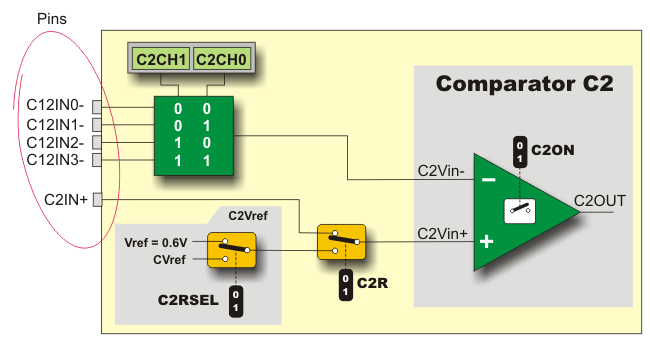
Fig. 7-11 Comparator C2 Schematic Diagram
- 1 - Comparator C2 is enabled; and
- 0 - Comparator C2 is disabled.
If C2POL = 1 (comparator output inverted)
- 1 - Analog voltage at C1Vin+ is lower than analog voltage at C1Vin-; and
- 0 - Analog voltage at C1Vin+ is higher than analog voltage at C1Vin-.
- 1 - Analog voltage at C1Vin+ is higher than analog voltage at C1Vin-; and
- 0 - Analog voltage at C1Vin+ is lower than analog voltage at C1Vin-.
- 1 - Comparator C2OUT output is connected to the C2OUT pin.*; and
- 0 - Comparator output is internal only.
C2POL - Comparator C2 Output Polarity Select bit enables comparator C2 out put state to be inverted.
- 1 - Comparator C2 output is inverted; and
- 0 - Comparator C2 output is non-inverted.
- 1 - Non-inverting input C2Vin+ is connected to reference voltage C2Vref; and
- 0 - Non-inverting input C2Vin+ is connected to the C2IN+ pin.
| C2CH1 | C2CH0 | Comparator C2Vin- input |
|---|---|---|
| 0 | 0 | Input C2Vin- is connected to the C12IN0- pin |
| 0 | 1 | Input C2Vin- is connected to the C12IN1- pin |
| 1 | 0 | Input C2Vin- is connected to the C12IN2- pin |
| 1 | 1 | Input C2Vin- is connected to the C12IN3- pin |
Table 7-5 Comparator C2 Channel Select Bit
CM2CON1 Register

Fig. 7-12 CM2CON1 Register
MC2OUT Mirror Copy of C2OUT bit
C1RSEL Comparator C1 Reference Select bit
- 1 - Selectable voltage CVref is used in voltage reference C1Vref source; and
- 0 - Fixed voltage reference 0.6V is used in voltage reference C1Vref source.
- 1 - Selectable voltage CVref is used in voltage reference C2Vref source; and
- 0 - Fixed voltage reference 0.6V is used in voltage reference C2Vref source.
- 1 - Timer T1gate source is T1G; and
- 0 - Timer T1gate source is comparator SYNCC2OUT.
- 1 - Comparator C2 output is synchronized to falling edge of Timer TMR1 clock; and
- 0 - Comparator output is asynchronous signal.
VRCON Register

Fig. 7-13 VRCON Register
- 1 - Voltage reference CVref source is powered on; and
- 0 - Voltage reference CVref source is powered off.
- 1 - Voltage reference CVref is connected to the pin; and
- 0 - Voltage reference CVref is disconnected from the pin.
- 1 - Voltage reference source is set to low range; and
- 0 - Voltage reference source is set to high range.
- 1 - Voltage reference source is in the range of Vref+ to Vref-; and
- 0 - Voltage reference source is in the range of Vdd - Vss (power supply voltage).
If VRR = 1 (low range)
Voltage reference is calculated using the formula: CVref = ([VR3:VR0]/24)Vdd
If VRR = 0 (high range)
Voltage reference is calculated using the formula: CVref = Vdd/4 + ([VR3:VR0]/32)Vdd
In Short:
In order to properly use built in Comparators, it is necessary to do the following:Step 1 - Configuring module:
- In order to select the appropriate mode, bits of the registers CM1CON0 and CM2CON0 should be configured. Interrupt should be disabled on any change of mode.
- Select one of two voltage ranges using the VRR bit;
- Configure necessary Vref using bits VR3 - VR0;
- Set the VROE bit if needed; and
- Enable voltage Vref source by setting the VREN bit.
VRR = 1 (low range)
CVref = ([VR3:VR0]/24)VLADDER
VRR = 0 (high range)
CVref = (VLADDER/4) + ([VR3:VR0]VLADDER/32)
Vladder = Vdd or ([Vref+] - [Vref-]) or Vref+
Step 3 - Starting operation:
- Enable interrupt by setting bits CMIE (PIE register), PEIE and GIE (both in the INTCON register);
- Read bits C1OUT and C2OUT of the CMCON register; and
- Read flag bit CMIF of the PIR register. After being set, this bit must be cleared in software.